|
|
|
Ghrelin Receptor Antagonist (GHRP-6) |
Antagonism of ghrelin receptor
reduces food intake and body weight gain in mice |
Ghrelin is a GH (GH) releasing peptide, which also
has an important role as an orexigenic hormone stimulating food
intake. By measuring inositol phosphate turnover or by using a reporter
assay for transcriptional activity controlled by cAMP responsive
elements, the ghrelin receptor showed strong, ligand-independent
signaling in transfected COS-7 or HEK293 cells. Ghrelin and a number
of the known non-peptide GH secretagogues acted as agonists stimulating
inositol phosphate turnover further. In contrast, the low potency
ghrelin antagonist, [D-Arg(1),D-Phe(5),D-Trp(7,9),Leu(11)]-substance
P was surprisingly found to be a high potency (EC50 = 5.2 nM) full
inverse agonist as it decreased the constitutive signaling of the
ghrelin receptor down to that observed in un-transfected cells.
The homologous motilin receptor functioned as a negative control
as it did not display any sign of constitutive activity; however,
upon agonist stimulation the motilin receptor signaled as strongly
as the un-stimulated ghrelin receptor. It is concluded that the
ghrelin receptor is highly constitutively active and that this activity
could be of physiological importance in its role as a regulator
of both GH secretion and appetite control. It is suggested that
inverse agonists for the ghrelin receptor could be particularly
interesting for the treatment of obesity.
|
Holst B, et al. Mol Endocrinol.
2003 Aug 7 [Epub ahead of print].
|
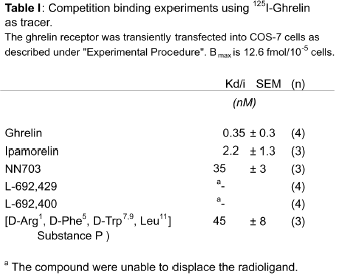 
|
| 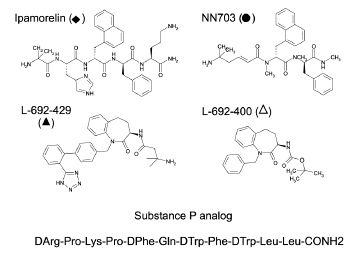 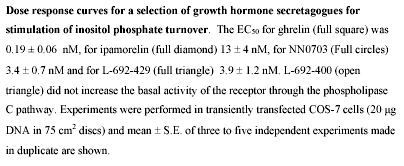
|
|
|
|  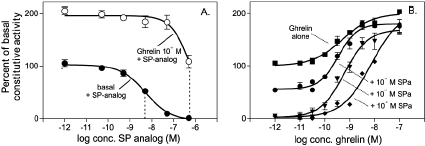
|
|
|
| 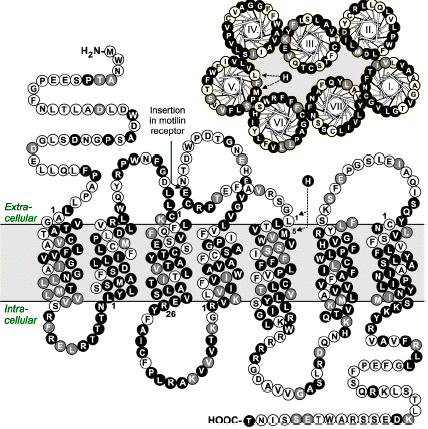 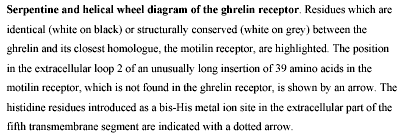
|
Ghrelin is a 28-amino-acid peptide, with an essential n-octanoyl
modification at Ser3, that elicits growth-hormone (GH) secretion
in rats and humans. At present, the mechanisms of ghrelin action
and its interactions with other systems controlling GH secretion
remain poorly characterized. In this context, the present study
was undertaken to obtain information about ontogeny and possible
gender differences in the GH-releasing activity of ghrelin, and
to delineate its primary site(s) of action at the hypothalamus and/or
pituitary. In addition, the interactions between ghrelin and other
relevant signals in the control of GH secretion, such as excitatory
amino acids (EAAs), nitric oxide (NO) and serotonin, were assessed.
Experiments were carried out in infantile-prepubertal animals, when
GH pulsatility is not yet established. Systemic administration of
ghrelin (25 nmol/rat, i.p.) to 5-, 10- and 23-day-old male and female
rats increased plasma GH levels from day 10 onwards. This action
was NO dependent, since it disappeared in 23-day-old males after
pretreatment with an inhibitor of NO synthase (NAME). Similarly,
central infusion of ghrelin (3 nmol/rat, i.c.v.) elicited GH responses
in 10- and 23-day-old animals significantly higher than after systemic
administration. By contrast, in vitro challenge of pituitary tissue
with increasing doses of ghrelin (10(-9)-10(-7) M) failed to enhance
GH release into the incubation medium, whereas stimulation with
GH-releasing hormone (GHRH; 10(-7) M) or GHRP-6 (10(-7) M) was effective.
Finally, effects of ghrelin were blocked by pretreatment with MK-801
and NBQX antagonists of EAA ionotropic receptors and after manipulation
of endogenous serotoninergic tone. In addition, the potent releasing
activity of EAA agonists NMDA and AMPA was blunted by pretreatment
with D-Lys3-GHRP-6, a selective antagonist of the cognate ghrelin
receptor, i.e. the GH-secretagogue receptor. In conclusion, our
results demonstrate that GH-releasing activity of ghrelin appears
early in the infantile period, is NO dependent and involves a primary
hypothalamic site of action. The data also demonstrate for the first
time the existence of a cross-talk between ghrelin and other neurotransmitter
systems, such as EAAs and serotonin, in precise control of GH secretion.
|
Pinilla
L, et al. Neuroendocrinology 2003 Feb;77(2):83-90
The structural relationship between the motilin and the growth hormone secretagogue receptor (GHS-R), and between their respective ligands, motilin and ghrelin, prompted us to investigate whether ghrelin and the GHS-R agonist, growth hormone releasing peptide-6 (GHRP-6), could interact with the motilin receptor. The interaction was evaluated in the rabbit gastric antrum with binding studies on membrane preparations and with contraction studies on muscle strips in the presence of selective antagonists under conditions of electrical field stimulation (EFS) or not. Binding studies indicated that the affinity (pKd) for the motilin receptor was in the order of: ghrelin (4.230.07) < GHRP-6 (5.540.08) < motilin (9.130.03). The interaction of ghrelin with the motilin receptor requires the octanoyl group. Motilin induced smooth muscle contractile responses but ghrelin and GHRP-6 were ineffective. EFS elicited on- and off-responses that were increased by motilin already at 10(-9) M, but not by 10(-5) M ghrelin. In contrast, GHRP-6 also enhanced the on- and off-responses. The motilin antagonist, GM-109, blocked the effect of GHRP-6 on the off- but not on the on-responses. Under NANC conditions the effects of motilin and GHRP-6 on the on-responses were abolished, those on the off-responses were preserved. All responses were blocked by NK1 and NK2 antagonists. In conclusion, ghrelin is unable to induce contractions via the motilin receptor. However, GHRP-6 enhances neural contractile responses, partially via interaction with the motilin receptor on non-cholinergic tachykininergic nerves, partially via another receptor that may be a GHS-R subtype on cholinergic nerves that corelease tachykinins.
Depoortere I, et al. J Pharmacol Exp Ther 2003 Feb 11; [epub ahead of print]
|
BACKGROUND AND AIMS: Ghrelin, an endogenous ligand
for growth hormone secretagogue receptor (GHS-R), is an appetite
stimulatory signal from the stomach with structural resemblance
to motilin. We examined the effects of the gastric peptide ghrelin
and GHS-R antagonists on energy balance and glycaemic control
in mice.
MATERIALS AND METHODS: Body weight, fat mass, glucose,
insulin, and gene expression of leptin, adiponectin, and resistin
in white adipose tissue (WAT) were measured after repeated administrations
of ghrelin under a high fat diet. Gastric ghrelin gene expression
was assessed by northern blot analysis. Energy intake and gastric
emptying were measured after administration of GHS-R antagonists.
Repeated administration of GHS-R antagonist was continued for
six days in ob/ob obese mice.
RESULTS: Ghrelin induced remarkable
adiposity and worsened glycaemic control under a high fat diet.
Pair feeding inhibited this effect. Ghrelin elevated leptin mRNA
expression and reduced resistin mRNA expression. Gastric ghrelin
mRNA expression during fasting was increased by a high fat diet.
GHS-R antagonists decreased energy intake in lean mice, in mice
with diet induced obesity, and in ob/ob obese mice; it also reduced
the rate of gastric emptying. Repeated administration of GHS-R
antagonist decreased body weight gain and improved glycaemic control
in ob/ob obese mice.
CONCLUSIONS: Ghrelin appears to be closely
related to excess weight gain, adiposity, and insulin resistance,
particularly under a high fat diet and in the dynamic stage. Gastric
peptide ghrelin and GHS-R may be promising therapeutic targets not only for anorexia-cachexia but also for obesity and type 2
diabetes, which are becoming increasingly prevalent worldwide.
Asakawa A, et al. Gut. 2003 Jul;52(7):947-52
|
|
|
LF, saline |
HF, saline |
HF, ghrelin |
|
| Calorie intake (kcal/day) |
18.83 (1.055) |
23.22 (1.329) |
25.94 (2.562)* |
| Fat pad mass(g) |
0.533 (0.049) |
0.797 (0.095) |
1.202 (0.175)** |
| Skeletal musde (g) |
0.337 (0.016) |
0.353 (0.010) |
0.340 (0.005) |
| Glucose (mmol/l) |
7.899 (0.476) |
8.393 (0.825) |
8.909 (0.498) |
| Insulin (pmol/l) |
135.0 (20.10) |
177.5 (13.05) |
378.0 (141.8)* |
| Cholesterol (mmol/l) |
3.742 (0.337) |
5.568 (0.497) |
5.813 (0.509)** |
| Triglycerides (mmol/l) |
0.347 (0.032) |
0.305 (0.039) |
0.371 (0.090) |
| Free fatty acids (meq/l) |
1.467 (0.050) |
1.623 (0.100) |
1.636 (0.047) |
|
| Results are expressed
as mean (SEM). |
| LF and HF indicate
a standard diet and a high fat diet, respectively. |
| *p<0.05, **p<0.01
between saline treated mice fed a standard diet
and ghrelin treated mice fed a high fat diet. |
 p<0.05
between saline treated mice fed a high fat diet
and ghrelin treated mice fed a high fat diet. p<0.05
between saline treated mice fed a high fat diet
and ghrelin treated mice fed a high fat diet. |
|
|
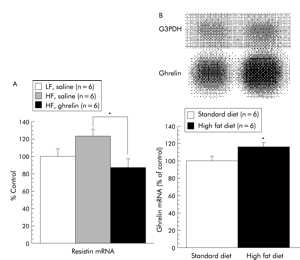
|
Chronic effects of ghrelin administered intraperitoneally (3 nmol/mouse
every 12 hours for five days) on resistin gene expression in the
epididymal fat mass under a high fat (HF) diet, as assessed by
northern blot analysis, expressed as a percentage of physiological
saline treated controls under a standard (LF) diet. Results are
expressed as mean (SEM): n indicates the number of mice used,
*p<0.05 between saline treated mice fed a high fat diet and
ghrelin treated mice fed a high fat diet. (B) Stimulatory effects
of a high fat diet for two weeks on ghrelin gene expression in
the stomach of food deprived mice, as assessed by northern blot
analysis, expressed as a percentage of standard diet fed controls.
(Top) A representative northern blot analysis showing gastric
ghrelin mRNA during fasting after a high fat diet for two weeks;
*p<0.05 compared with the control group by Bonferroni’/�8s
t test. G3PDH, glyceraldehyde 3-phosphate dehydrogenase.
|
| 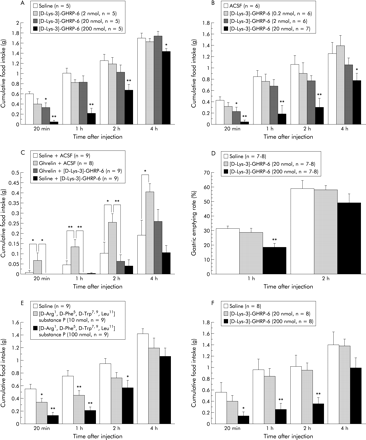
|
Effects of intraperitoneally administered [D-Lys-3]-GHRP-6 (2–/�(200
nmol/mouse) on cumulative food intake in food deprived lean mice:
*p<0.05, **p<0.01 compared with the control group by Bonferroni’/�8s
t test. (B) Effects of intracerebroventricularly administered
[D-Lys-3]-GHRP-6 (0.2–/�(20 nmol/mouse) on cumulative food intake
in food deprived lean mice. ACSF, artificial cerebrospinal fluid.
(C) Antagonistic effects of [D-Lys-3]-GHRP-6 administered intracerebroventricularly
(20 nmol/mouse) on feeding induced by intraperitoneal injection
of ghrelin (3 nmol/mouse) in non-food deprived lean mice. (D)
Inhibitory effects of intraperitoneally administered [D-Lys- 3]-GHRP-6
(20–/�(200 nmol/mouse) on the gastric emptying rate one and two
hours after injection in lean mice. (E) Effects of intraperitoneally
administered [D-Arg-1, D-Phe-5, D- Trp-7, 9, Leu-11] substance
P (10–/�(100 nmol/mouse) on cumulative food intake in food deprived
lean mice. (F) Effects of intraperitoneally administered [D-Lys-3]-GHRP-6
(20–/�(200 nmol/mouse) on cumulative food intake in mice with
diet induced obesity who received a high fat diet for two weeks.
|
| 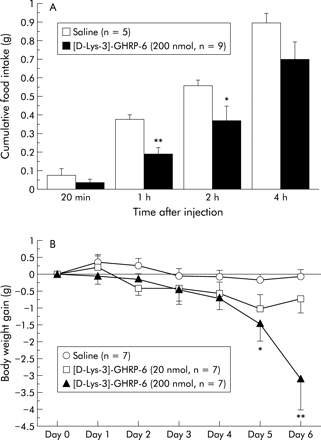
|
Acute effects of intraperitoneally administered [D-Lys-3]-GHRP-6
(200 nmol/mouse) on cumulative food intake in food deprived ob/ob
obese mice: *p<0.05, **p<0.01 compared with physiological
saline treated controls. (B) Chronic effects of [D-Lys- 3]-GHRP-6
administered intraperitoneally (20–/�(200 nmol/mouse every 12
hours for six days) on body weight gain in non-food deprived ob/ob
obese mice.
|
|
|
Saline |
20 nmol |
200 nmol |
|
| Food intake (g/day) |
4.845 (0.160) |
4.527 (0.261) |
4.285 (0.298) |
| Fat pad mass (g) |
0.974 (0.066) |
0.897 (0.169) |
0.860 (0.086) |
| Skeletal muscle (g) |
0.300 (0.012) |
0.314 (0.009) |
0.326 (0.013) |
| Glucose (mmolli) |
13.01 (1.538) |
12.06 (1.549) |
7.489 (1.081)* |
| Insulin (pmol/1) |
8294 (1676) |
6242 (1628) |
5481 (1304) |
| Cholesterol (mmol/1) |
6.649 (0.346) |
5.663 (0.291) |
5.906 (0.565) |
| Triglycerides (mmol/l) |
0.518 (0.049) |
0.436 (0.040) |
0.465 (0.068) |
| Free fatty acids (meq/l) |
2.164 (0.075) |
2.036 (0.121) |
1.646 (0.078)** |
|
| *p<0.05,
**p<0.01 compared with physiological saline treated
controls. |
|
|
| |
| |
| |
|
|
|
%GHRP%;%GHRF%
|
|
|


